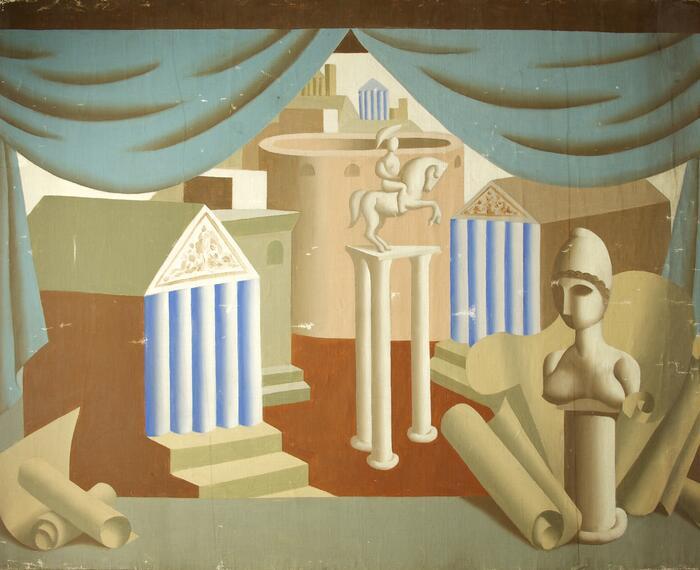


Joshua Leon, 'The Missing O and E' (2024). Installation view, Chisenhale Gallery, London, 2024. Commissioned and produced by Chisenhale Gallery, London. Photo: Andy Keate.
Chisenhale Gallery, 64 Chisenhale Road, London, E3 5QZ
23 February – 21 April 2024
Upon entering the exhibition titled ‘The Missing O and E’ by Joshua Leon, one is struck by the intentionally sparse arrangement of works on show that explore themes of concealment, erasure and nuanced personal memory coupled with historical records. The conceptual framework of sound and noise feels integral to our semiotic understanding of the exhibition, serving as a prominent device that permeates the gallery through holistic approximations.
Sitting down on an ‘f’ shaped veneered bench (one of two in the show), I am drawn to the negative space of ‘holes’ typically found in a violin that has been inverted and made ‘whole’ through meticulous carpentry. Leon uses veneered wood that materially amplifies the previous life of the Chisenhale building as a former veneer factory. This nuanced, historical, unearthing and rearticulation of the gallery is further amplified through two letters stained onto the windows – O and E. The exhibition re-imagines these letters as if they were missing components, lifted and displaced from the side of the building, where the original C, H and N inscriptions were resurrected (restored from the original 1940’s signage). Cumulatively, these letters anagrammatically suggest the name ‘Cohen’ (referencing the buildings former owner Morris Cohen), but also highlight the socio-political ellipses and codes imposed on diasporic communities. Questions arise as to why the O and E were never ascribed in the first place. In a time of rising fascism in 1940’s Europe, the withholding of one’s identity for fear of persecution becomes apparent. For Leon, the emphasis here is on the codification of Jewish life, its history and the clandestine signs that perpetuated such erasure.
Ultimately, the work highlights the nature of the human condition and our affinity to time and space, that which yearns to trace and re-imagine concealed histories, particularly those which hold such deeply personal significance.
At intervals a sound score plays out across the gallery space featuring one single isolated violin that references Leon’s grandfather and his role in the London philharmonic orchestra in the 1950s. I was struck, not only by the presence of music, but also by the weight of its absence (or to be more specific the presence of noise substituting a seemingly purposeful and structured composition). At these points of inflection, the sounds of the outside covertly emanate through the space – birdsong, traffic and even the weather. The artist and composer John Cage once gave an interview on silence where he equates music to talking and sound to acting, and it is these two terms – talking and acting – that feel so prominent throughout the works. The voice of the individual, who speaks directly and intimately in contrast to acting, or even performativity, that unfolds as a survival mechanism and byproduct of daily life. At the point at which the composition ceases, it’s as if the aleatoric elements of the outside world reach a crescendo that subsumes the space previously occupied by the voice of the lone violinist. Arguably, this replicates the way in which a single instrument loses its autonomy in an orchestra, becoming the wider sum of parts.
The final works on the wall are a series of veneer framed records that feature several orchestra programmes, spaced apart like notes on a score sheet and varying in their veneer tones. The 9 wall works show Leon’s grandfather’s name as it is gradually altered through time, at points prescribed and at other moments desired. There is an indeterminacy at play through the varied alterations of one’s name, and by extension one’s identity. Metaphorically speaking, the interplay of works in the show suggests the presiding role that the collective voice holds over the individual – and whilst at times this collective utterance is essential, it also predicates a momentary point of concealment for the individual and their personal identity.
Leon deftly harnesses the ephemeral qualities of Chisenhale’s architecture and places this in dialogue with historical records and material/sculptural re-constitution, culminating in a pertinent and sensitive address of memory, re-imagined histories and coded lineages.
Jordan Mouzouris,
Curator, Digital
Chisenhale Gallery, 64 Chisenhale Road, London, E3 5QZ
Gallery opening hours: Wednesday - Sunday, 12 - 6pm (during exhibitions) Office hours: Monday to Friday, 10am – 6pm